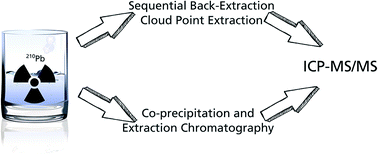Attogram measurement of 210Pb in drinking water by ICP-MS/MS
Abstract
In this article, we report the first the use of inductively coupled plasma tandem mass spectrometry (ICP-MS/MS, Agilent 8800) as a rapid alternative for the time-consuming measurement of 210Pb in drinking water by radiometric approaches. After thorough cross-optimization of the tandem mass spectrometer to maximize signal-to-noise ratio at m/z 210, an instrumental detection limit of 314 fg L−1 (0.9 Bq L−1) was achieved. The presence of polyatomic interferences at m/z 210 were found to be more predominant for Pt > Bi > Er suggesting that sample preparation is mandatory prior to mass spectrometric determination of 210Pb at regulatory levels. Thus, two extraction approaches were investigated: combined co-precipitation and extraction chromatography (CoP-EXC), and sequential back extraction cloud point extraction (BE-CPE). Drinking water samples were treated using both techniques and analyzed by ICP-MS/MS. Detection limits of the method were found to be 15 (45) and 18 fg L−1 (50 mBq L−1) for BE-CPE and CoP-EXC, respectively. BE-CPE provided higher extraction (80%), preconcentration factor (78), daily sample throughput (36) and shorter sample turnaround time (4.5 hours) than its CoP-EXC counterpart while successfully mitigating the potential interferences at m/z 210.



 Please wait while we load your content...
Please wait while we load your content...